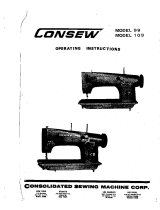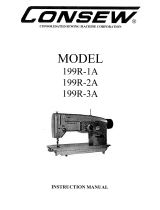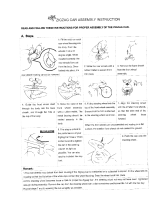Page is loading ...

52Xi
Industrial sewing machine
Service Instructions
Serviceanleitung
Postfach 17 03 51, D-33703 Bielefeld • Potsdamer Straße 190, D-33719 Bielefeld
Telefon +49 (0) 521 / 9 25-00 • Telefax +49 (0) 521 / 9 25 24 35 • www.duerkopp-adler.com
Ausgabe / Edition: Aenderungsindex Teile-Nr./Part.-No.:
07/2009 Rev. index: 00.0 Printed in Czech Republic S735 000805
D
GB

Alle Rechte vorbehalten.
Eigentum der Dürkopp Adler AG und urheberrechtlich geschützt. J ede, auch auszugsweise Wiederverwendung
dieser Inhalte ist ohne vorheriges schriftliches Einverständnis der Dürkopp Adler AG verboten.
All rights reserved.
Property of Dürkopp Adler AG and copyrighted. Reproduction or publication of the content in any manner, even
in extracts, without prior written permission of Dürkopp Adler AG, is prohibited.
Copyright ©
Dürkopp Adler AG - 2009

Introduction
This service booklet contains the instructions for setting the sewing machine
head mechanisms.
The directions for putting the machine into operation and for setting the
positioning drive are contained in another publication.
The service booklet is common for all subclasses of the machine and
contains also the instructions for setting optional accessories of the machine,
if this is necessary owing to their complexity. Provided the machine supplied
does not contain some elements, then the respective chapters may be
ignored.
The succession of the setting operations is expressed here by sequencing
the paragraphs of this booklet. When setting, check up, if the setting
operations related to this setting have already been performed.

General safety regulations
The non-observance of the following safety instructions can cause
bodily injuries or damages to the machine.
1. The machine must only be commissioned in full knowledge of the
instruction book and operated by persons with appropriate training.
2. Before putting into service also read the safety rules and instructions of
the motor supplier.
3. The machine must be used only for the purpose intended. Use of the
machine without the safety devices is not permitted. Observe all the
relevant safety regulations.
4. When gauge parts are exchanged (e.g. needle, presser foot, needle
plate, feed dog and bobbin) when treading, when the workplace is left,
and during service work, the machine must be disconnected from the
mains by switching off the master switch or disconnecting the mains
plug.
5. Daily servicing work must be carried out only by appropriately trained
persons.
6. Repairs, conversion and special maintenance work must only be carried
out by technicians or persons with appropriate training.
7. For service or repair work on pneumatic systems the machine must be
disconnected from the compressed air supply system.
Exceptions to this are only adjustments and function checks made by
appropriately trained technicians.
8. Work on the electrical equipment must be carried out only by electricians
or appropriately trained persons.
9. Work on parts and systems under electric current is not permitted,
except as specified in regulations DIN VDE 0105.
10. Conversions or changes to the machine must be authorized by us and
made only in adherence to all safety regulations.
11. For repairs, only replacement parts approved by us must be used.
12. Commissioning of the sewing head is prohibited until such time as the
entire sewing unit is found to comply with EC directives.
13. The connecting cable must be provided with a permissible local specific
network socket. This work requires trained and qualified professionals
(see point 8 too).
It is absolutely necessary to respect the safety
instructions marked by these signs.
Danger of bodily injuries !
Please note also the general safety instructions.

GB
List of contents Page
Introduction and safety regulations
Instructions for the machine setting - class 52X
1. Zigzag stitch mechanism of machines 523, 524, 527
1.1. Introduction .................................................. 5
1.2 Tooth clearance setting of zigzag stitch gear .............................. 5
1.3 Straightstitchalignment .......................................... 6
1.4 Zigzagstitchwidth.............................................. 7
1.5 Needle stab position setting in feeding direction ............................ 8
1.6 Lateral setting of needle stab position .................................. 9
1.7 Lateralsettingofcentralstraightstitchposition ............................ 10
1.8 Lateral setting of straight stitches on throat plate needle hole edges,
arresting of zigzag stitch setting mechanism .............................. 11
2. Form stitch mechanism of machine 525
2.1 Introduction .................................................. 12
2.2 Tooth clearance setting of form stitch gear ............................... 12
2.3 Rollerboltpositionofformstitchsteeringcam ............................ 13
2.4 Setting of needle stab position ...................................... 14
2.5 Timing o f form stitch s teering cam to needle motion ......................... 14
3. Feeding and presser foot
3.1 Stitch length setting mechanism ..................................... 15
3.2 Zero stitch length............................................... 16
3.3 Feeddogpositioninthroatplaterecessanditsheight........................ 17
3.4 Timingoffeeddogmotioneccentricinsewingdirection ....................... 18
3.5 Timingoffeeddogverticalmotion .................................... 19
3.6 Backtacking with solenoid ......................................... 20
3.7 Manual foot lifting .............................................. 21
3.8 Footliftingwithkneelever......................................... 22
3.9 Foot lifting with solenoid .......................................... 23
4. Setting of needle bar and hook
4.1 Hooktiming(loopstroke) ......................................... 24
4.2 Needle bar height, space between needle and hook point ...................... 25
4.3 Bobbin c ase driver .............................................. 26
4.4 Bobbin case lifting .............................................. 27
5. Thread mechanism
5.1 Threadlimiter,checkspring........................................ 28
5.2 Bobbin w inder................................................. 29

6. Thread trimmer
6.1 Trimmingpressureoftrimmingknives.................................. 30
6.2 Threadtrimmerlever ............................................ 31
6.3 Driver...................................................... 32
6.4 Threadtrimmercam............................................. 33
7. Machine electronic control and drive ................................. 34

1. Zigzag stitch mechanism of machines 523, 524, 527
1.1 Introduction
The machine setting must be carried out in the sequence as described
herein.
1.2 Tooth clearance setting of zigzag stitch gear
Regulation
The tooth clearance of zigzag stitch should be as small as possible.
No overlap instead of clearance, however, may arise in any mutual
position of the gears.
–
Dismantle the machine top cover.
–
Loosen the screw (1) and turn the eccentric bolt (2) until the gear
fitted on it strikes the gear (3). With regard of the gear runout,
caused by manufacturing inaccuracy, turn the hand wheel by 1/4
revolution, and set the clearance again.
Repeat this 8 times (2 revolutions of the main shaft), until the
eccentric bolt (2) position with the smallest tooth clearance is
found. Locate the bolt ( 2) in this position and fix it with a screw (1).
5
GB
132

1.3 Straight stitch alignment
Regulation
The centrally positioned straight stitch must be fully aligned, i. e. the
needle must not have any lateral motion.
–
Set the zero stitch length.
–
Loosen the screw (1).
–
Place the stop pin (2) to the stop onto the casing (3).
–
Place a piece of paper onto the throat plate and turn the hand
wheel there and back until the needle point makes 2 holes in the
paper.
–
Loosen 3 screws (4) and try to set the casing (3) angle position
until the needle, when being turned, stabs there and back in the
same hole in the paper.
–
Tighten the screws (3).
–
Fix the lever (5) so that the mark (6) is located opposite the zero on
the zigzag stitch s cale (7).
6
6
4
2
3
7
5
1
4

1.4 Zigzag stitch width
Regulation
The zigzag stitch width setting must be limited to the value prescribed
for the applied sewing equipment with the setting tolerance -5% of the
prescribed value.
–
Set the zero stitch length.
–
Place a piece of paper onto the throat plate.
–
Loosen the screw (1).
–
Try to set the lever (2) in the position corresponding with the
required zigzag stitch width. Turn the hand wheel there and back
until the needle makes 2 holes in the paper. Measure their
distance. Change the lever position (2) until the distance of the
holes complies with the regulation.
–
Shift the screw (1) to the stop and tighten it.
7
GB
2
1

1.5 Needle stab position setting in feeding direction
Regulation
If the needle is in the bottom dead center, it should be positioned in the
throat plate needle hole center in feeding direction and its lost motion
in the feeding direction should be as small as possible.
–
Place the needle in the bottom dead center.
–
Loosen the arresting screws (1), (2), and the regulating screw (3).
–
Adjust the screw (4) so that the regulation is complied with and
arrest it with the screw (1).
–
Adjust the regulating screw (3) so that the lost motion (play) of the
needle bar holder in the arrow direction is the smallest achievable
one; rubbing must not occur.
–
Tighten the screw (2).
8
4
3
1
2

1.6 Lateral setting of needle stab position
Regulation
Both dead centers of the needle lateral motion at the zigzag stitch
sewing should be at the same distance from the throat plate needle
hole edges.
–
Dismantle the cover (1) and the hole stop (2) from the rear side.
–
Loosen both screws (3).
–
Set the maximum zigzag stitch w idth and adjust the positions of the
needle lateral motion dead centers as per regulation.
–
Tighten both screws properly (3).
9
G
B
1
3
3
2

1.7 Lateral setting of central straight stitch position
Regulation
If the central straight stitch is set, the needle position should be
approximately in the center of the presser foot or in the middle of the
throat plate needle hole center.
–
Set the zero width of the zigzag stitch with the lever (1).
–
Loosen the screws (2).
–
Shift the lever (3) until the needle shifts in the lateral direction to
the throat plate needle hole center.
–
Tighten the screws (2).
10
32 1

1.8 Lateral setting of straight stitches on throat plate needle hole edges,
arresting of zigzag stitch setting mechanism
Regulation
If the sewing equipment allows using the maximum zigzag stitch width,
which is characteristic of the particular machine type, the position of
the border straight stitches should b e adjusted so that it aligns with the
zigzag stitch border. If the throat plate needle hole is narrower than the
maximum zigzag stitch width of the particular sewing machine type, the
lever for the position setting of the border stitch must be fixed in the
central position.
–
Loosen the screw (1) and turn the lever (2) in the position, in which
the needle will perform no lateral motion when turning the lever (3).
–
Locate the stop (4) to the lever (2) and fix it w ith the screw (1).
–
Loosen the screw (5) and turn the lever (2) to the position, in which
the needle performs no side motion when moving the lever (3).
–
Locate the stop (6) to the lever (2) and fix it w ith the screw (5).
–
Adjust the arresting lever (7) in this position.Tighten the arresting
nut (8-invisible), loosen the screw (9), turn the lever (7) to 1 mm
space from the casing (10) and tighten the screw (9).
–
If the sewing equipment does not allow using the maximum zigzag
stitch width, screw the regulating screw (11) into the lever (2) and
fix it in the central position.
11
GB
241 3
2115 6 8 9
3710

2. Form stitch mechanism of machine 525
2.1 Introduction
The setting should be carried out in the sequence as described herein.
2.2 Tooth clearance setting of form stitch gear
Regulation
The tooth clearance of the form stitch gear should be as small as
possible. No overlap instead of clearance, however, may arise in any
mutual position of the gears.
–
Dismantle the top cover.
–
Turn the hand wheel 12 times in intervals of approximately 1/3
revolution and ascertain the tooth clearance, turning the steering
cam (1) manually until the position with the smallest tooth
clearance is found.
–
Loosen the screws (2), turn the gear in the smallest tooth
clearance position, shift the cone scroll (3) to the right and set
the tooth clearance as small as possible. Tighten the screws (2).
–
Mount the regulating ring (4) on touch with the scroll (3).
–
Check the tooth clearance.
12
13
42

GB
2.3 Roller bolt position of form stitch steering cam
Regulation
When changing the form stitch width, the stitch central axis should
remain in its place. It should not shift laterally.
–
Mount the wheel steering cam of the straight stitch (from the
machine rear side).
–
Dismantle the cover of the form stitch width setting mechanism.
–
Release the bolt (1) position by tilting the lever (2) in yourself
direction.
–
Move the bolt (1) in the arrow direction and watch whether the
needle is moving laterally. If yes, dismantle the steering cam,
loosen the screw (3) and try to turn the eccentric bolt (4) to a
different position and test whether the needle is changing its
position. Repeat this until the eccentric bolt (4) position is found
where the needle position does not change.
–
Tighten the screw (3).
13
2
1
3
4

2.4 Setting of needle stab position
Regulation
If the wheel steering cam of the straight stitch is mounted, the needle
should be located in both directions in the center of the throat plate
needle hole.
–
Adjust the needle position in feeding direction as per section 1.5.
–
Adjust the needle lateral position similarly as in section 1.6 so that
the needle is located in the needle hole center.
2.5 Timing of form stitch steering cam to needle motion
Regulation
When sewing the form stitch, the needle should shift in the lateral
direction at the time when it is over the sewn material.
–
Dismantle the top cover.
–
Mount any form stitch cam (1).
–
Loosen 4 screws (2) and turn the scroll (3) to the position where
the regulation is complied with. Put the scroll (3) on touch with the
regulating ring (4) and fix it.
–
Check whether the needle is without any motion at the time when it
is stabbed in the sewn material and adjust the setting, if needed.
14
13
42

3. Feeding and presser foot
3.1 Stitch length setting mechanism
Regulation
If the zero stitch length is set, the hand lever should perform no lost
motion.
–
Loosen the screws (1).
–
Set the setting knob (2) on the zero stitch length.
–
Shift the lever (3) in the arrow direction until its fork is in bilateral
contact with the screw spherical end on the knob (2) axis.
–
Tighten the screws (1).
–
Check whether the backtacking lever (4) performs any lost motion
in this position.
15
GB
2
1
3
4

3.2 Zero stitch length
Regulation
If the zero stitch length is set, the connecting rod (3) should perform no
motion.
–
Set the stitch length knob on the zero cipher.
–
Tilt the machine and loosen the screw (1).
–
Shift the sleeve (2) until the position is found where the connecting
rod (3) stops moving.
–
Tighten the screw (1).
16
3
21

GB
3.3 Feed dog position in throat plate recess and its height
Regulation
The feed dog should not touch the throat plate laterally. At the zero
stitch length the teeth should be located in the throat plate recess
center. If the feed dog is positioned in the top dead center, it s hould be
located 1 mm over the throat plate and its top surface should be
parallel with the throat plate.
–
Set the zero stitch length.
–
Loosen the screws (1) and (2). Shift the whole mechanism laterally
so that the feed dog does not touch the throat plate.
–
Shift the feed dog so that the spaces (4) and (5) are the same and
tighten the screw (1).
–
Loosen the screws (3), turn the eccentric bolt (6) and the lever (7)
until the feed dog protrudes from the throat plate by 1 mm in front
and at the back.
–
Tighten the screws (3) and (2).
–
Set the maximum stitch length and check whether the spaces (4)
and (5) are the same in the dead centers of the feed dog motion.
17
27
54
3
1
6

3.4 Timing of feed dog motion eccentric in sewing direction
Regulation
If the needle is lifted b y 1 mm from the bottom dead center, the feed
dog should not move when the backtacking lever is pressed down.
–
Set the maximum stitch length.
–
Turn the hand wheel in yourself direction until the needle is in the
bottom dead center and then turn until the needle lifts by 1 mm.
–
Take care that the needle position remains unaffected and loosen
two screws (1).
–
Turn the shaft (2) manually and find its position where the feed dog
does not move at the backtacking lever (4) shifting. At the same
time, the longitudinal groove in the roller (3) should be turned close
(visible).
18
321
4
/












